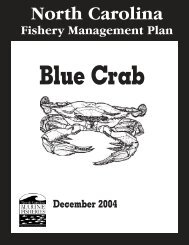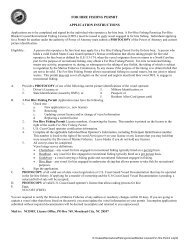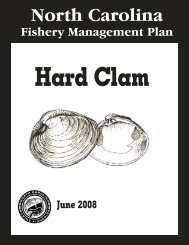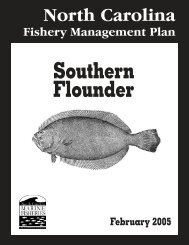Striped Mullet FMP - NC Dept. of Environment and Natural Resources
Striped Mullet FMP - NC Dept. of Environment and Natural Resources
Striped Mullet FMP - NC Dept. of Environment and Natural Resources
You also want an ePaper? Increase the reach of your titles
YUMPU automatically turns print PDFs into web optimized ePapers that Google loves.
200 mm FL [Leard et al. 1995 (Appendix1, Table 2)]. Lengths at annuli formations were variedamong studies that used both scales <strong>and</strong> otoliths for aging [Leard et al. 1995 (Appendix 1,Table 2)].AdultsAdults grow at a rate <strong>of</strong> 38 to 64 mm per year (Broadhead 1953; <strong>NC</strong>DMF 2001b).Spring <strong>and</strong> summer growth is twice as fast as fall <strong>and</strong> winter growth (Broadhead 1953; Rivas1980). Adults grew 7 mm in each <strong>of</strong> the first <strong>and</strong> fourth quarters <strong>of</strong> the year, <strong>and</strong> averaged 16<strong>and</strong> 19 mm growth in the second <strong>and</strong> third quarters <strong>of</strong> the year in a Florida tagging study(Broadhead 1958).Otolith growth is closely related to body growth for fishes (Helfman et al. 1997).Incremental otolith growth in striped mullet occurs primarily from July to November in Louisiana(Thompson et al. 1991) <strong>and</strong> June to October in North Carolina (<strong>NC</strong>DMF 2001a). Thompson etal. (1991) indicated that energy required for somatic growth was reallocated for reproduction<strong>and</strong> post-spawning recovery (during the fall <strong>and</strong> winter, November - March). Summer growthdepression in striped mullet (age 1+) was observed in Texas, associated with prolongedelevation <strong>of</strong> water temperatures <strong>and</strong> potential shifts in food types (Moore 1973; Cech et al.1975). A similar cessation in marginal incremental growth in otoliths was observed for olderstriped mullet in August <strong>and</strong> September in North Carolina (<strong>NC</strong>DMF 2001a).Males <strong>and</strong> females are at similar lengths at early ages (< age 2), after which, femalesgrow larger <strong>and</strong> live longer [Table 5.1 (Mamhoudi et al. 1990; DMF unpublished data)]. Largevariability in size at early ages is seen in North Carolina, South Carolina, <strong>and</strong> Georgia stocks(Foster 2001; McDonough 2001;<strong>NC</strong>DMF 2001a). North Carolina striped mullet appear toachieve larger mean lengths at earlier ages than more southern U.S. states (Bichy 2000;<strong>NC</strong>DMF 2001a). For example, mean length for age 1 striped mullet (both sexes) in SouthCarolina was 257 mm, substantially smaller than males <strong>and</strong> females (317, 346 mm) in NorthCarolina (McDonough 2001; DMF unpublished data). On average, age 2 males <strong>and</strong> females inSouth Carolina were 310 mm compared to 344 mm <strong>and</strong> 394 mm in North Carolina (McDonough2001; DMF unpublished data). Since birth date is st<strong>and</strong>ardized as January 1 for agingconvention along the U.S. east coast, earlier spawning times <strong>and</strong> true birth dates in NorthCarolina may contribute to slightly larger mean lengths at young ages.20












